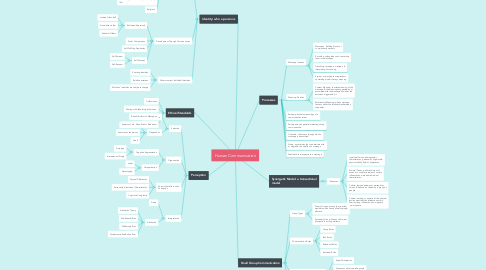
1. Perception
1.1. Selection
1.1.1. Selective Attention
1.1.2. Depends on
1.1.2.1. Aspects of identity
1.1.2.2. Features of the person
1.1.2.3. Goals
1.2. Organisation
1.2.1. Cognitive Represntation
1.2.1.1. Prototype
1.2.1.2. Interpersonal Scripts
1.2.2. Categorisation
1.2.2.1. Label
1.2.2.2. Stereotyping
1.3. Factors that affect one's Perception
1.3.1. Physical Differences
1.3.2. Personality & Individual Characteristics
1.3.3. Cognitive Complexity
1.4. Interpretation
1.4.1. Frame
1.4.2. Attribution
1.4.2.1. Attribution Theory
1.4.2.2. Attributional Bias
1.4.2.3. Self-Serving Bias
1.4.2.4. Fundamental Attribution Error
2. Ethical Standards
2.1. Truthfulness
2.2. Sharing or Withholding Information
2.3. Benefit & Harm of Messages
2.4. Absolutism v Relativism
3. Identity: who a person is
3.1. Individual Identity & Society
3.1.1. Racial
3.1.2. Ethmic
3.1.3. National
3.1.4. Gender
3.1.5. Age
3.1.6. Social Class
3.1.7. Disability (identification with physical or mental impairment that impacts everyday life)
3.1.8. Religious
3.2. Development Through Communication
3.2.1. Reflected Appraisals
3.2.1.1. Looking Glass-Self
3.2.1.2. Generalised other
3.2.1.3. Particular Others
3.2.2. Social Comparisons
3.2.3. Self-Fulfilling Prophecies
3.2.4. Self-Concept
3.2.4.1. Self-Esteem
3.2.4.2. Self-Respect
3.3. Performance of Individual Identities
3.3.1. Enacting Identities
3.3.2. Role Expectations
3.3.3. Mutable" identities are subject to change
4. Processes
4.1. Message Creation
4.1.1. Messages: Building blocks of communication events
4.1.2. Encoding: taking ideas and converting them into messages
4.1.3. Decoding: receiving a message & interpreting its meaning
4.1.4. Symbol: something that represents something else & conveys meaning
4.2. Meaning Creation
4.2.1. Content Meaning: concrete meaning of the message, & the meanings suggested by or associated with the message as well as the emotions triggered by it
4.2.2. Relationship Meaning: what a message conveys about the relationships between the parties
4.3. Setting: physical surroundings of a communication event
4.4. Participants: the people interacting during communication
4.5. Channels:: the means through which a message is transmitted
4.6. Noise: any stimulus that can interfere with, or degrade, the quality of a message
4.7. Feedback: the response to a message
5. Synergetic Model: a transactional model
5.1. Influences
5.1.1. Individual Forces: demographic characteristics, personality, cognitive & physical ability, field of experience
5.1.2. Societal Forces: political, historical, economic, social structures of society influences how we view individual characteristics
5.1.3. Culture: learned patterns of perceptions, values, & behaviours shared by a group of people
5.1.4. Context: setting, or aspects of the physical environment that the interaction occurs. Exerts strong influence on how people communicate
6. Small Group Communication
6.1. Group Types
6.1.1. Primary Groups: groups that provide members with a sense of belonging & affection
6.1.2. Secondary Group: Groups that meet principally to solve problems
6.2. Communication Roles
6.2.1. Group Roles
6.2.2. Task Roles
6.2.3. Relational Roles
6.2.4. Individual Roles
6.3. Effective small group communication
6.3.1. Equal Participation
6.3.2. Consensus decision-making style
6.3.3. A cooperation conflict style
6.3.4. A respectful communication style
6.4. Ladder of Activities
6.4.1. Sharing (freedom of individuals to participate)
6.4.2. Cooperation (involves changing of behaviour to synchronise with people who change their behaviour for you)
6.4.3. Collective Action (requires group of people to commit themselves to undertake a particular effort together)

